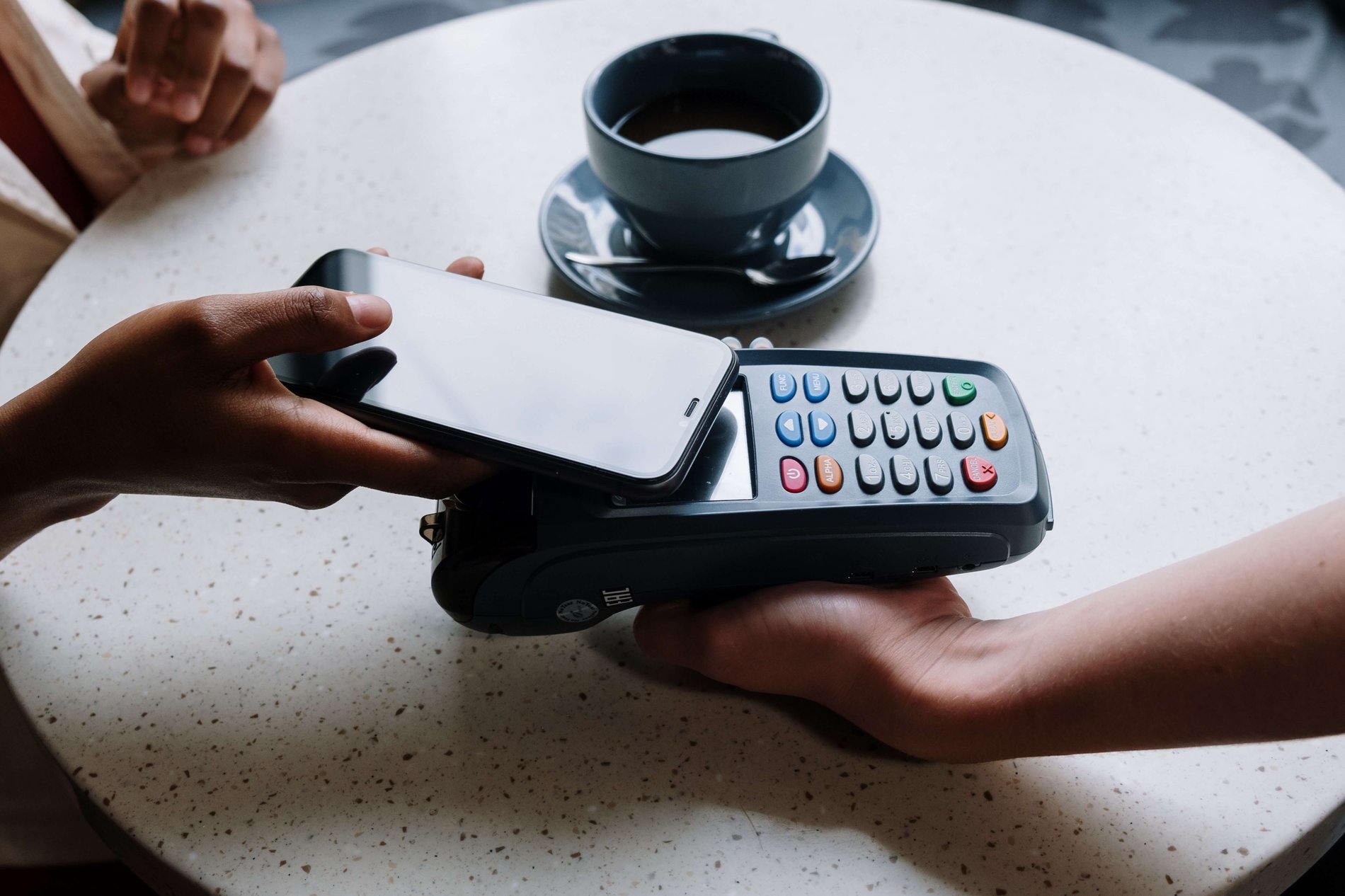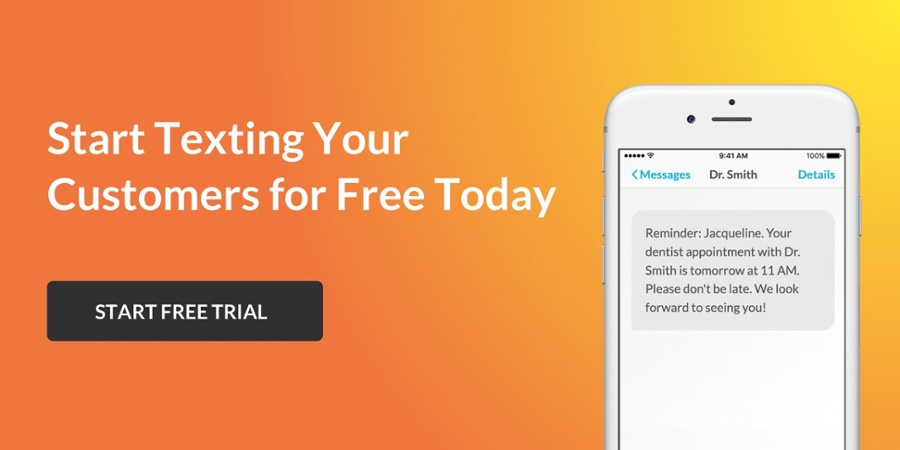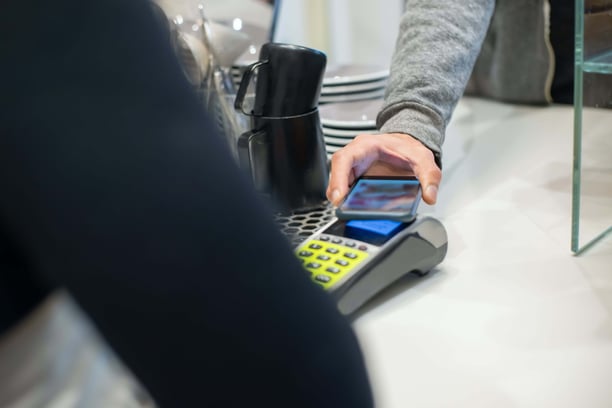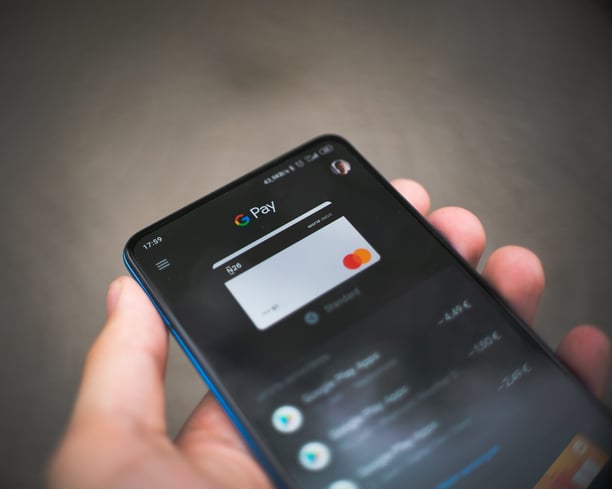As we move away from physical payments like cash and cards, it’s becoming increasingly important for businesses to offer alternative payment methods to their customers. The shift is so widespread that 43% of small business customers carry less cash and, instead, opt for digital methods – like mobile payment.
But what is mobile payment, and is it a worthwhile investment for business owners?
Mobile payment refers to any payment made using a mobile device, whether it’speer-to-peer or customer-to-business. It’s convenient for customers, as it eliminates the need to carry a physical wallet – and it’s beneficial to businesses as it allows them to streamline payment processes, reduce transaction costs and enhance the customer experience.
An increasingly popular mobile payment option is text-to-pay, which allows customers to make purchases by sending a text message to a business. This is particularly useful for small, quick transactions, like buying a cup of coffee or paying a restaurant bill, as it speeds up the buying process and ensures a secure transaction.
Here’s everything you need to know about mobile payments and why they’re valuable to any modern business.
Table of Contents
- Types of mobile payments
- Advantages of mobile payments
- Challenges faced by mobile payments
- Mobile payment adoption rate
- Future of mobile payments
Types of Mobile Payments
Here are three popular mobile payment options used to facilitate customer-to-business transactions:
SMS-Based Payment (Text-to-Pay)
SMS-based payment, also known as text-to-pay, refers to a mobile payment method where customers can make purchases or payments by sending a text message to a designated number.
When using SMS to make a payment, the customer initiates the transaction by sending a specific code or keyword in addition to the payment amount via SMS. The business or service provider then confirms the payment request and charges the customer’s registered payment method, typically a credit or debit card.
Thanks to convenience and ease of use, businesses are finding that more customers want to pay by text messages. However, only 4% of small businesses offer this payment option, meaning there’s a massive opportunity for companies that adopt it early.
Read More: Text to Pay: Passing Trend or Massive Opportunity?
Contactless Payment
Contactless payment allows customers to make transactions without physical contact with a payment terminal or device. It utilizes near-field communication (NFC) and radio-frequency identification (RFID) to facilitate secure and wireless communication between the customer’s mobile device or contactless card and the payment terminal.
Customers can complete transactions quickly and securely by tapping, waving, or bringing their device or card close to the terminal. Contactless payment methods include mobile wallets, contactless cards and wearable devices like Apple Watches. These payments are completed in seconds and require little to no effort for the customer.
Mobile Wallet
A mobile wallet is a digital application or service that allows users to securely store and manage their payment information using a mobile device. It enables users to link their credit or debit cards to a mobile “wallet,” which can be used to make payments, transfer money and perform other financial transactions through their device.
Some mobile wallets provide additional features like loyalty card integration, transaction history, and budgeting tools, offering users a comprehensive and convenient way to manage finances.
Mobile wallets are a secure, convenient alternative to physical payment methods, and they provide flexibility for users to make payments on the go – whether in-store, online or through user-to-user transfers.
Advantages of Mobile Payments
Mobile payments offer several advantages that benefit both businesses and consumers. Let’s explore some of the perks of implementing mobile payments into your business practice:
Convenience
With a mobile device in hand, customers can leave physical wallets or cash behind and make payments whenever they’d like. Whether shopping online or in-store, the ease of completing transactions with a quick tap of a smartphone enhances customer experience.
Mobile payments allow businesses to accept payments anytime, anywhere. Whether it’s a brick-and-mortar store, a pop-up event, or an online shop, businesses can offer mobile payment options to their customers, providing flexibility and meeting their preferences. This convenience expands the opportunities for sales, allowing businesses to capture transactions beyond traditional point-of-sale terminals.
Furthermore, mobile payments often integrate with customer-centric features like loyalty programs and digital receipts. By consolidating these functions into a mobile payment platform, businesses can offer their customers a more streamlined and cohesive experience. This enhances customer engagement, encourages repeat business and fosters brand loyalty.
Security
Mobile payments offer significant security-related benefits to businesses, providing a robust layer of protection for both the business and its customers.
Mobile payment platforms employ encryption techniques to safeguard sensitive payment information during transmission. Encryption converts data into a coded form, making it unreadable to unauthorized individuals. Tokenization replaces actual card numbers with unique tokens, further protecting customer data by ensuring that sensitive information is not stored on the merchant’s systems. These security measures reduce the risk of data breaches and fraudulent activities.
Furthermore, many mobile devices support biometric authentication methods like fingerprint scanning or facial recognition. By utilizing these features, mobile payments offer an additional layer of security. Biometric data is unique to each individual, making it difficult for unauthorized users to access or make payments using someone else’s device or credentials.
Mobile payments also reduce the risk of card fraud compared to traditional payment methods. With mobile wallets, payment credentials are securely stored on the device and are less susceptible to theft or unauthorized access. This reduces the chances of card skimming or cloning, meaning peace of mind for both businesses and customers.
Speed and Efficiency
Mobile payments enable businesses to expedite checkout by providing quick, effortless replacements for traditional payment methods. The streamlined process reduces checkout times, especially during peak business hours. This enhances customer satisfaction and improves operational efficiency for businesses.
By using mobile payments, businesses can receive immediate transaction confirmation and funds. Unlike traditional payment methods that require batch processing or manual reconciliation, mobile payment platforms provide real-time transaction data and settlement. This allows businesses to have an accurate and up-to-date view of their financial status, streamline cash flow management and make more informed decisions.
Additionally, the ability to send digital receipts instead of a physical copy eliminates the need for paper receipts and simplifies the record-keeping process for businesses. This also allows customers to easily access their transaction history, which enhances transparency and enables efficient returns or exchanges.
Cost-Effectiveness
By replacing traditional point-of-sale terminals with existing mobile divides such as smartphones or tablets, the need to invest in costly payment terminals upfront and pay for ongoing maintenance is eliminated.
Mobile payment platforms also offer competitive processing fees compared to traditional payment methods. By leveraging digital payment solutions, businesses can benefit from lower transaction fees and save money over time.
Challenges of Mobile Payments
As with any payment method, there are risks involved. Here are some potential risks you should consider for all mobile transactions:
Lack of Consumer Awareness
Mobile devices are pocket-sized, meaning they are susceptible to loss and theft and, like all computers, can be vulnerable to malware, viruses and other cyberattacks. This may cause customers to feel concerned about the security and privacy of mobile payments. The lack of familiarity with the technology can also hinder their adoption of these payment methods.
Limited Infrastructure
Many mobile payments, like mobile wallets and peer-to-peer (P2P) apps like Venmo and Cash App, rely on reliable internet connectivity to process transactions. To provide customers with diverse options, it's crucial to include alternatives that are not dependent on internet connectivity, such as text-to-pay.
Regulatory Issues
Mobile payments involve the transmission and storage of sensitive customer data, so regulatory frameworks are in place to address data privacy, security and ensure the integrity of transactions.
Businesses must comply with various data protection regulations, like the General Data Protection Regulation (GDPR) or Payment Card Industry Data Security Standard (PCI DSS), to safeguard customer information and prevent data breaches.
Fortunately, Textedly prioritizes data encryption during the transmission and storage of customer data and integrates with secure payment gateways that comply with these industry standards.
Mobile Payment Adoption Rate
Mobile payments have seen a stark increase since 2020. Here’s what you need to know:
Important Statistics
- The number of mobile payment users worldwide is projected to reach 1.31 billion in 2023 as mobile payments across different industries and regions grow in popularity.
- 68% of Gen Z consumers are interested in instant person-to-person payments, which is more than any other age group.
- 67% of consumers believe retailers who utilize mobile technology provide a faster shopping experience.
- 79% of consumers use contactless payments, citing safety and cleanliness as key drivers.
- The U.S. mobile payment market is expected to reach $11.83 billion by 2028.
Factors Contributing to Mobile Payment Adoption
Several factors have contributed to the rise of mobile payments, including the following:
- Digitalization and contactless trends. The COVID-19 pandemic has accelerated the shift toward digital payments and contactless transactions. Mobile payments offer a hygienic and touch-free alternative to traditional payment methods, aligning with the growing preference for contactless transactions.
- Convenience and ease of use. Mobile payment methods offer unparalleled convenience to consumers. Users can complete transactions anytime, anywhere with just a few taps on their smartphones.
- Security and trust. Mobile payment providers have implemented robust security measures to safeguard users’ financial information.
- Increasing smartphone penetration. The widespread adoption of smartphones globally has played a significant role in the rise of mobile payments. As more people buy and use smartphones, the accessibility and availability of mobile payment services have expanded, making it easier for individuals to adopt this payment method.
- Integration with other services. Mobile payment apps often integrate additional features like loyalty programs, discounts, and personalized offers, enhancing user experience and incentivizing customers to adopt mobile payment methods.
- Government initiatives and regulations. Governments and regulatory bodies have actively supported and promoted mobile payment adoption by providing incentives like demonetization, regulatory frameworks and interoperability standards.
The Future of Mobile Payments
Mobile payments hold tremendous potential as technology continues to advance and businesses recognize the value of embracing digital transaction options.
We will continue to see innovation in mobile payment technology, and emerging technologies like near-field communication (NFC), biometric authentication and blockchain will enhance the security, speed and convenience of mobile payments.
Mobile payment apps will likely focus heavily on user experience by focusing on delivering personalized experiences to users. Data analytics and machine learning will be leveraged to better understand user preferences and offer tailored promotions, loyalty rewards and recommendations.
As a result of consumers' increasing reliance on mobile payments, more and more businesses will accept such transactions.
Stay Future-Focused with Textedly
Mobile payments will soon become the go-to payment method for businesses and consumers alike. Text-to-pay services will take up a large portion of this, as it benefits all involved parties.
Text-to-pay by Textedly will keep your business future-focused, enabling you to submit payment reminders, streamline recurring payments and boost your cash flow through a secure system that safeguards your customers’ data.
Streamline your business’s payment process and schedule a demo with us today!







.png)